 The whistle is made from 1/2" and 1/8" thick pieces of wood. I used oak,
which is a fairly porous wood. A denser closer-grained wood would
probably be a better choice.
The whistle is made from 1/2" and 1/8" thick pieces of wood. I used oak,
which is a fairly porous wood. A denser closer-grained wood would
probably be a better choice.
 The whistle is made from 1/2" and 1/8" thick pieces of wood. I used oak,
which is a fairly porous wood. A denser closer-grained wood would
probably be a better choice.
The whistle is made from 1/2" and 1/8" thick pieces of wood. I used oak,
which is a fairly porous wood. A denser closer-grained wood would
probably be a better choice.
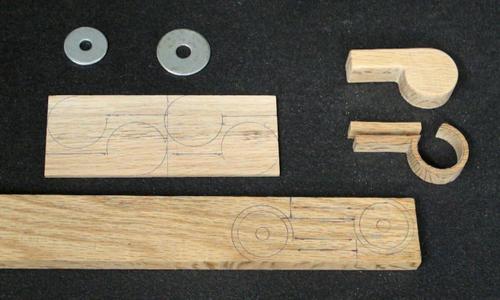 Exact dimensions are not critical. I drew concentric circles of the 1/2"
thick body using 1-1/4" diameter and 1" diameter fender washers. The
inside circle is used to align the Forstner bit. The 1-1/4" diameter
fender washer was also used to draw the 1/8" thick side caps.
Exact dimensions are not critical. I drew concentric circles of the 1/2"
thick body using 1-1/4" diameter and 1" diameter fender washers. The
inside circle is used to align the Forstner bit. The 1-1/4" diameter
fender washer was also used to draw the 1/8" thick side caps.
Matthias adds:
I have CAD captured the whistle, but did the drawing in metric. You can make a 1:1 printout of the drawings at left by downloading the eval version of my BigPrint program and just dragging the image at left onto the program. Or you can print the print the pdf. You can alslo download the whistle SketchUp model
The middle layer should be cut 13 mm thick, the two sides 3 mm thick.
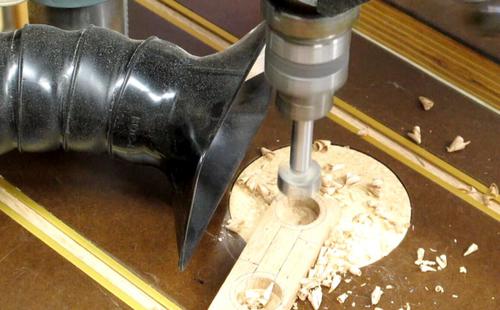 Drill the body with a Forstner bit or cut it out with a scroll saw.
Drill the body with a Forstner bit or cut it out with a scroll saw.
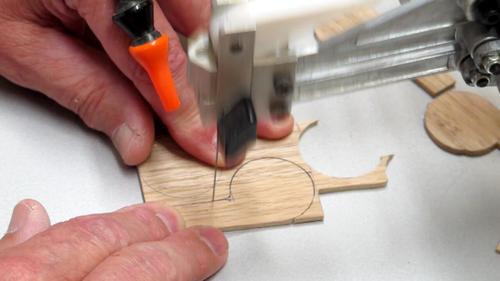 I used a scroll saw to cut the body and the side caps. The mouthpiece of
the whistle is split lengthwise with a saw and the wind cutter at the
other end of the opening is cut at a 60 deg angle.
I used a scroll saw to cut the body and the side caps. The mouthpiece of
the whistle is split lengthwise with a saw and the wind cutter at the
other end of the opening is cut at a 60 deg angle.
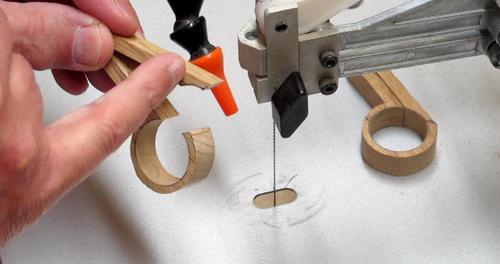 Shorten the end of the top part of the mouthpiece, either by cutting
or by sanding. Sand both inside faces of the mouthpiece
(what will be the air slot) smooth. The inside
of the body should be smooth. Maintain the sharp edge of the wind
cutter.
Shorten the end of the top part of the mouthpiece, either by cutting
or by sanding. Sand both inside faces of the mouthpiece
(what will be the air slot) smooth. The inside
of the body should be smooth. Maintain the sharp edge of the wind
cutter.
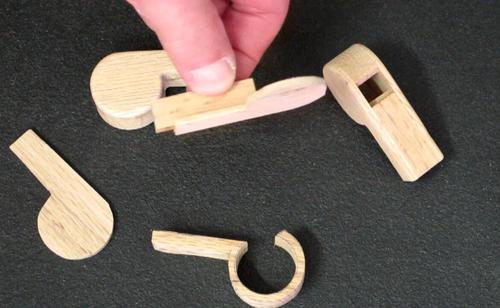 Glue the top of the mouthpiece to one of the side caps.
Glue the top of the mouthpiece to one of the side caps.
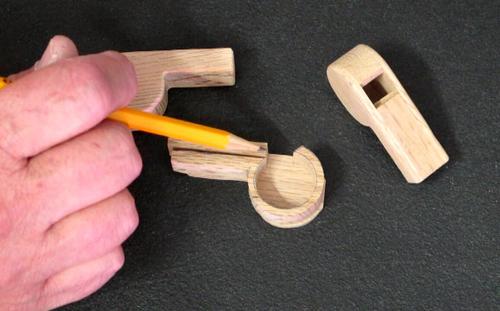 Now is your opportunity to "tune" your whistle. Temporarily place the
body of the whistle on the side cap, aligning the parts as shown with an
approximate 1/16" slot between the top and bottom portions of the
mouthpiece.
Now is your opportunity to "tune" your whistle. Temporarily place the
body of the whistle on the side cap, aligning the parts as shown with an
approximate 1/16" slot between the top and bottom portions of the
mouthpiece.
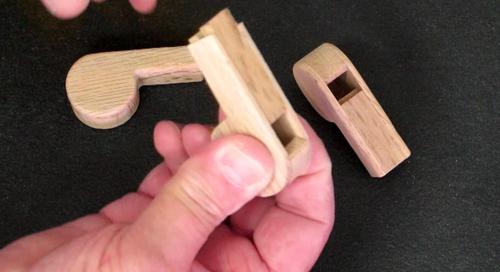 Place the second side cap into position and hold the parts together.
Place the second side cap into position and hold the parts together.
Blow on the whistle to test it.
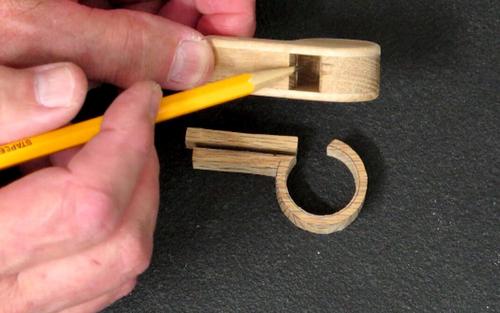 Make sure your whistle is going to sound its best by adjusting the body
position and the size of the air slot. When you are happy with the
sound, glue the parts together. I filed and sanded everything smooth and
radiused the edges.
Make sure your whistle is going to sound its best by adjusting the body
position and the size of the air slot. When you are happy with the
sound, glue the parts together. I filed and sanded everything smooth and
radiused the edges.
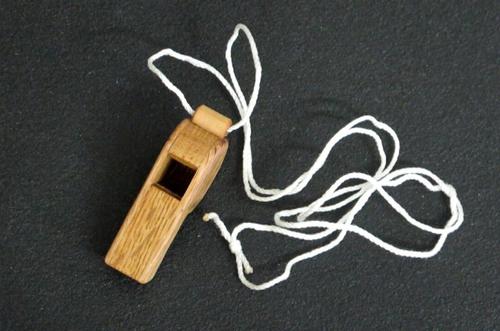 I used a short piece of 3/8" dowel and concaved one side to fit the
curvature of the body and glued it to the body. Then I drilled a hole in
the center of that dowel for attaching a lanyard.
I used a short piece of 3/8" dowel and concaved one side to fit the
curvature of the body and glued it to the body. Then I drilled a hole in
the center of that dowel for attaching a lanyard.
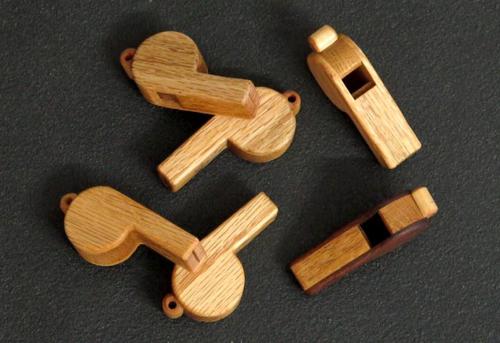 The oak was given a couple of coats of linseed oil (inside and outside)
and it sounds fine. Sealing with varnish would also be good. Be careful
not to plug up the air slot with varnish.
The oak was given a couple of coats of linseed oil (inside and outside)
and it sounds fine. Sealing with varnish would also be good. Be careful
not to plug up the air slot with varnish.
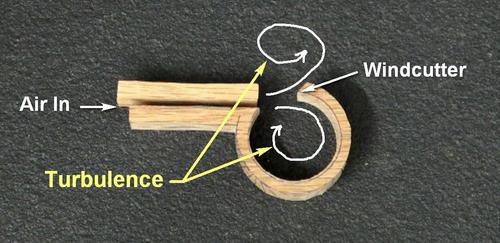 Experiment with the various dimensions of the whistle and you can
probably reduce the size of the mouth enabling the use of a small ball
or pellet inside the body, which will tumble around in the turbulent air
when you blow on the whistle. The tumbling ball will disrupt the airflow
creating pressure fluctuations within the body and the warbling sound we
associate with a police whistle.
Experiment with the various dimensions of the whistle and you can
probably reduce the size of the mouth enabling the use of a small ball
or pellet inside the body, which will tumble around in the turbulent air
when you blow on the whistle. The tumbling ball will disrupt the airflow
creating pressure fluctuations within the body and the warbling sound we
associate with a police whistle.
Enjoy your whistle!